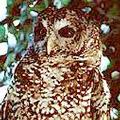 加拿大卑詩省農業及土地部部長貝爾29日宣佈,卑詩省政府未來5年將耗資數百萬加幣,復育該省境內瀕臨絕種的斑點梟(spotted owl)。但環保團體卻認為,多年來政府一直將他們提出的斑點梟滅絕警訊當成耳邊風,而現在提出的復育計劃,其實只是為了讓卑詩省在2010年舉辦冬季奧運時,看起來更體面的裝飾品而已。
加拿大卑詩省農業及土地部部長貝爾29日宣佈,卑詩省政府未來5年將耗資數百萬加幣,復育該省境內瀕臨絕種的斑點梟(spotted owl)。但環保團體卻認為,多年來政府一直將他們提出的斑點梟滅絕警訊當成耳邊風,而現在提出的復育計劃,其實只是為了讓卑詩省在2010年舉辦冬季奧運時,看起來更體面的裝飾品而已。
卑詩省府表示,這項保育計畫內容牽涉到人工繁殖和野放斑點梟,將牠們遷移到新棲息地,增加食物來源以及管理其他如橫斑林梟(barred owl)等相互競爭的物種。
但是保育團體指出,政府不會停止砍伐提供斑點梟棲息地的古森林。他們指出,省政府的木材出售計畫將持續下去,省府成為貓頭鷹棲息地的最大伐木者。環保團體譴責政府的保育計畫,並且指出計畫將剛好在2010年的奧運之後結束。
2010年冬季奧運的舉行地點延伸長達120公里從列治文、溫哥華南方到冰雪覆蓋的惠斯勒山度假勝地,涵蓋貓頭鷹的棲息地。
森林倫理組織的巴提奇表示:「假使卑詩省政府的保育計劃在奧林匹克結束後馬上結束,那麼這就是一項愚弄大眾和國際社會的計畫,而不是為了要拯救斑點梟。這項計畫會是斑點梟滅絕之路而非復育藍圖。如果卑詩省政府認真看待拯救貓頭鷹問題,他們就會保護足夠的棲息地來復育物種。」
保育人士呼籲終止砍伐加拿大境內斑點梟棲息的古森林。加拿大西部荒野委員會活動執行長佛伊表示:「卑詩政府選擇的做法是滅絕斑點梟而不是復育。人工繁殖卻沒有提供足夠且適當的棲息地,這表示年輕的斑點梟將會被野放到無法支持牠們生活的土地,而這真是糟糕透頂的保育科學。」
卑詩省政府的生物學家在2005年只發現了6對斑點梟,在不到10年的時間內數量下降了84%。科學家相信在工業伐林之前,有500對的斑點梟棲息在卑詩省西南部,這也是在加拿大唯一可以發現牠們的地方。環保團體認為,砍伐斑點梟的古森林棲息地,是數量持續下降的斑點梟的主要威脅。
貝爾的身分也有爭議。現任卑詩省農業及土地部部長的貝爾,2001年代表北部選區出馬競選省議員成功──該選區的經濟活動以伐木為主,同時他擁有貨運公司並與他人共同擁有一家伐木公司。貝爾主張北方斑點梟數量減少的原因不是出在伐木問題,而是因為其他競爭物種的關係。
The British Columbia government will implement a multi-million dollar, five year plan to recover the province's critically endangered northern spotted owl, Agriculture and Lands Minister Pat Bell announced Friday. Environmental groups, whose warnings about spotted owl extinction have fallen on deaf government ears for years, say the plan is just window dressing to make B.C. look good for the 2010 Winter Olympic Games.
Under the plan, the government says it will engage in captive breeding and release of spotted owls, moving owls to new locations, increasing food sources for owls, and managing competing species such as barred owls.
But logging in the old growth forests that provide spotted owl habitat will not stop. The B.C. government, through its Timber Sales Program, will continue as the largest logger of owl habitat, the conservation groups point out. Environmental groups condemned the government's plan, pointing out that it ends just after the 2010 Olympics.
The venues for the 2010 Olympics stretch over a 120 kilometer zone from Richmond, south of Vancouver, to the snowy peaks of Whistler mountain resort, an area that includes owl habitat.
"Given the B.C. government plan ends just after the Olympics, this is a plan to fool the public and the international community, not to save the spotted owl," said Candace Batycki of ForestEthics. "This announcement is a blueprint for extinction not a recovery plan. If the B.C. government was serious about saving the owl it would protect enough habitat to recover the species."
Conservationists are calling for an end to old-growth logging within the Canadian range of the owl. "The B.C. government is choosing extinction of the spotted owl over recovery," said Joe Foy, campaign director for the Western Canada Wilderness Committee. "Captive breeding without adequate habitat protection means young owls will be released into a landscape that cannot support them and that is just bad science."
In 2005, B.C. government biologists found only six pairs of owls, an 84 percent decline in less than a decade. Scientists believe that before industrial logging, 500 pairs of spotted owls lived in southwestern British Columbia, the only place in Canada where they are found. The main threat to the declining spotted owl population is logging of its old growth forest habitat, the environmental groups maintain.
But the British Columbia Agriculture and Lands Minister Pat Bell, who represents a northern district with an economy based on logging, owned a trucking company and co-owned a logging company before he won a seat in the provincial legislature in 2001, blames a competing species of owl, rather than logging, for the decline of Canada's only population of northern spotted owls.




